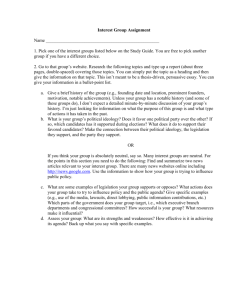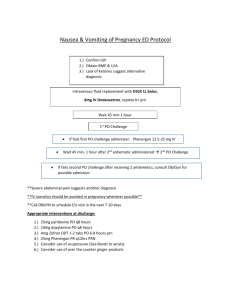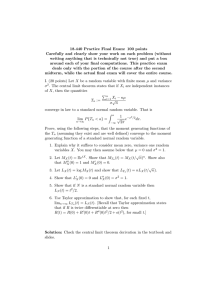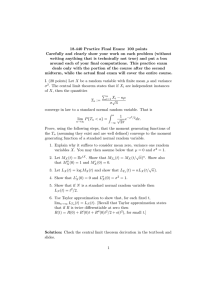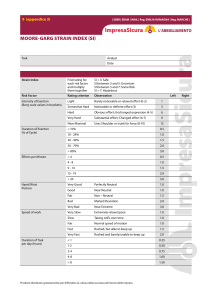18.440: Lecture 36 Risk Neutral Probability and Black-Scholes Scott Sheffield MIT
advertisement
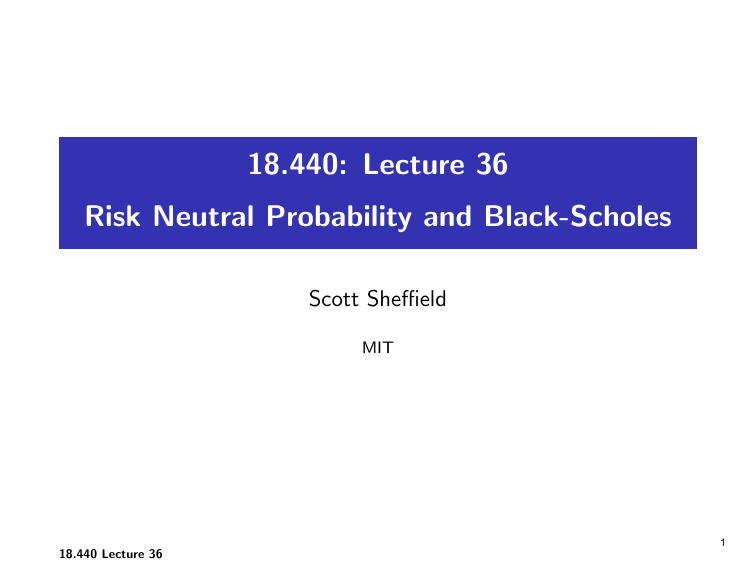
18.440: Lecture 36
Risk Neutral Probability and Black-Scholes
Scott Sheffield
MIT
1
18.440 Lecture 36
Outline
Risk neutral probability
Black-Scholes
2
18.440 Lecture 36
Outline
Risk neutral probability
Black-Scholes
3
18.440 Lecture 36
Overview
I
The mathematics of today’s lecture will not go far beyond
things we know.
I
Main mathematical tasks will be to compute expectations of
functions of log-normal random variables (to get the
Black-Scholes formula) and differentiate under an integral (to
compute risk neutral density functions from option prices).
I
Will spend significant time giving financial interpretations of
the mathematics.
I
Can interpret this lecture as a sophisticated story problem,
illustrating an important application of the probability we have
learned in this course (involving probability axioms,
expectations, cumulative distribution functions, etc.)
4
18.440 Lecture 36
Risk neutral probability
I
“Risk neutral probability” is a fancy term for “price
probability”. (The term “price probability” is arguably more
descriptive.)
I
That is, it is a probability measure that you can deduce by
looking at prices.
I
For example, suppose somebody is about to shoot a free
throw in basketball. What is the price in the sports betting
world of a contract that pays one dollar if the shot is made?
I
If the answer is .75 dollars, then we say that the risk neutral
probability that the shot will be made is .75.
I
Risk neutral probability is the probability determined by the
market betting odds.
5
18.440 Lecture 36
Risk neutral probability of outcomes known at fixed time T
I
Risk neutral probability of event A: PRN (A) denotes
Price{Contract paying 1 dollar at time T if A occurs }
.
Price{Contract paying 1 dollar at time T no matter what }
I
If risk-free interest rate is constant and equal to r
(compounded continuously), then denominator is e −rT .
I
Assuming no arbitrage (i.e., no risk free profit with zero
upfront investment), PRN satisfies axioms of probability. That
is, 0 ≤ PRN (A) ≤ 1, and PRN (S) = 1, and if events Aj are
disjoint then PRN (A1 ∪ A2 ∪ . . .) = PRN (A1 ) + PRN (A2 ) + . . .
I
Arbitrage example: if A and B are disjoint and
PRN (A ∪ B) < P(A) + P(B) then we sell contracts paying 1 if
A occurs and 1 if B occurs, buy contract paying 1 if A ∪ B
occurs, pocket difference.
6
18.440 Lecture 36
Risk neutral probability differ vs. “ordinary probability”
I
At first sight, one might think that PRN (A) describes the
market’s best guess at the probability that A will occur.
I
But suppose A is the event that the government is dissolved
and all dollars become worthless. What is PRN (A)?
I
Should be 0. Even if people think A is likely, a contract
paying a dollar when A occurs is worthless.
I
Now, suppose there are only 2 outcomes: A is event that
economy booms and everyone prospers and B is event that
economy sags and everyone is needy. Suppose purchasing
power of dollar is the same in both scenarios. If people think
A has a .5 chance to occur, do we expect PRN (A) > .5 or
PRN (A) < .5?
I
Answer: PRN (A) < .5. People are risk averse. In second
scenario they need the money more.
7
18.440 Lecture 36
Non-systemic event
I
Suppose that A is the event that the Boston Red Sox win the
World Series. Would we expect PRN (A) to represent (a
market assessment of) “true probability” in that case?
I
Arguably yes. The amount that people in general need or
value dollars does not depend much on whether A occurs
(even though the financial needs of specific individuals may
depend on heavily on A).
I
Even if some people bet based on loyalty, emotion, etc., there
will arguably be enough in-it-for-the-money statistical
arbitrageurs to keep price near a reasonable guess of “true
probability”.
8
18.440 Lecture 36
Extensions of risk neutral probability
I
Definition of risk neutral probability depends on choice of
currency (the so-called numéraire).
I
Risk neutral probability can be defined for variable times and
variable interest rates — e.g., one can take the numéraire to
be amount one dollar in a variable-interest-rate money market
account has grown to when outcome is known. Can define
PRN (A) to be price of contract paying this amount if and
when A occurs.
I
For simplicity, we focus on fixed time T , fixed interest rate r
in this lecture.
9
18.440 Lecture 36
Risk neutral probability is objective
I
Check out the contracts on intrade.com.
I
Many financial derivatives are essentially bets of this form.
I
Unlike “true probability” (what does that mean?) the “risk
neutral probability” is an objectively measurable price.
I
Pundit: The market predictions are ridiculous. I can estimate
probabilities much better than they can.
I
Listener: Then why not make some bets and get rich? If your
estimates are so much better, law of large numbers says you’ll
surely come out way ahead eventually.
I
Pundit: Well, you know... been busy... scruples about
gambling... more to life than money...
I
Listener: Yeah, that’s what I thought.
10
18.440 Lecture 36
Prices as expectations
I
By assumption, the price of a contract that pays one dollar at
time T if A occurs is PRN (A)e −rT .
I
If A and B are disjoint, what is the price of a contract that
pays 2 dollars if A occurs, 3 if B occurs, 0 otherwise?
I
Answer: (2PRN (A) + 3PRN (B))e −rT .
I
Generally, in absence of arbitrage, price of contract that pays
X at time T should be ERN (X )e −rT where ERN denotes
expectation with respect to the risk neutral probability.
I
Example: if a non-divided paying stock will be worth X at
time T , then its price today should be ERN (X )e −rT .
I
(Aside: So-called fundamental theorem of asset pricing
states that interest-discounted asset prices are martingales
with respect to risk neutral probability. Current price of stock
being ERN [Xe −rT ] follows from this.)
11
18.440 Lecture 36
Outline
Risk neutral probability
Black-Scholes
12
18.440 Lecture 36
Outline
Risk neutral probability
Black-Scholes
13
18.440 Lecture 36
Black-Scholes: main assumption and conclusion
I
I
I
I
I
I
I
More famous MIT professors: Black, Scholes, Merton.
1997 Nobel Prize.
Assumption: the log of an asset price X at fixed future time
T is a normal random variable (call it N) with some known
variance (call it T σ 2 ) and some mean (call it µ) with respect
to risk neutral probability.
2
Observation: N normal (µ, T σ 2 ) implies E [e N ] = e µ+T σ /2 .
Observation: If X0 is the current price then
2
X0 = ERN [X ]e −rT = ERN [e N ]e −rT = e µ+(σ /2−r )T .
Observation: This implies µ = log X0 + (r − σ 2 /2)T .
Conclusion: If g is any function then the price of a contract
that pays g (X ) at time T is
ERN [g (X )]e −rT = ERN [g (e N )]e −rT
where N is normal with mean µ and variance T σ 2 .
18.440 Lecture 36
14
Black-Scholes example: European call option
I
A European call option on a stock at maturity date T ,
strike price K , gives the holder the right (but not obligation)
to purchase a share of stock for K dollars at time T .
The document gives the
bearer the right to purchase one share of MSFT
from me on May 31 for
35 dollars. SS
I
I
I
If X is the value of the stock at T , then the value of the
option at time T is given by g (X ) = max{0, X − K }.
Black-Scholes: price of contract paying g (X ) at time T is
ERN [g (X )]e −rT = ERN [g (e N )]e −rT where N is normal with
variance T σ 2 , mean µ = log X0 + (r − σ 2 /2)T .
Write this as
e −rT ERN [max{0, e N − K }] = e −rT ERN [(e N − K )1N≥log K ]
Z ∞
(x−µ)2
e −rT
= √
e − 2T σ2 (e x − K )dx.
σ 2πT log K
18.440 Lecture 36
15
The famous formula
I
I
I
I
Let T be time to maturity, X0 current price of underlying
asset, K strike price, r risk free interest rate, σ the volatility.
(x−µ)2
R∞
We need to compute e −rT log K e − 2T σ2 (e x − K )dx where
µ = rT + log X0 − T σ 2 /2.
Can use complete-the-square tricks to compute the two terms
explicitly in terms of standard normal cumulative distribution
function Φ.
Price of European call is Φ(d1 )X0 − Φ(d2 )Ke −rT where
d1 =
ln(
2
X0
)+(r + σ2 )(T )
K
√
σ T
and d2 =
ln(
2
X0
)+(r − σ2 )(T )
K
√
σ T
.
16
18.440 Lecture 36
Determining risk neutral probability from call quotes
I
I
If C (K ) is price of European call with strike price K and
f = fX is risk neutral probabilit
R ∞y density function for X at
time T , then C (K ) = e −rT −∞ f (x) max{0, x − K }dx.
Differentiating under the integral, we find that
Z
rT 0
e C (K ) = f (x)(−1x>K )dx = −PRN {X > K } = FX (K )−1,
e rT C 00 (K ) = f (K ).
I
We can look up C (K ) for a given stock symbol (say GOOG)
and expiration time T at cboe.com and work out
approximately what FX and hence fX must be.
17
18.440 Lecture 36
Perspective: implied volatility
I
Risk neutral probability densities derived from call quotes are
not quite lognormal in practice. Tails are too fat. Main
Black-Scholes assumption is only approximately correct.
I
“Implied volatility” is the value of σ that (when plugged into
Black-Scholes formula along with known parameters) predicts
the current market price.
I
If Black-Scholes were completely correct, then given a stock
and an expiration date, the implied volatility would be the
same for all strike prices. In practice, when the implied
volatility is viewed as a function of strike price (sometimes
called the “volatility smile”), it is not constant.
18
18.440 Lecture 36
Perspective: why is Black-Scholes not exactly right?
I
Main Black-Scholes assumption: risk neutral probability
densities are lognormal.
I
Heuristic support for this assumption: If price goes up 1
percent or down 1 percent each day (with no interest) then
the risk neutral probability must be .5 for each (independently
of previous days). Central limit theorem gives log normality
for large T .
I
Replicating portfolio point of view: can transfer money
back and forth between the stock and the risk free asset to
ensure that wealth at the end equals option payout. Option
price is required initial investment, which is risk neutral
expectation of payout. “True probabilities” are irrelevant.
I
Where arguments for assumption break down: Fluctuation
sizes vary from day to day. Prices can have big jumps.
I
Fixes: variable volatility, random interest rates, Lévy jumps....
19
18.440 Lecture 36
MIT OpenCourseWare
http://ocw.mit.edu
18.440 Probability and Random Variables
Spring 2014
For information about citing these materials or our Terms of Use, visit: http://ocw.mit.edu/terms.

